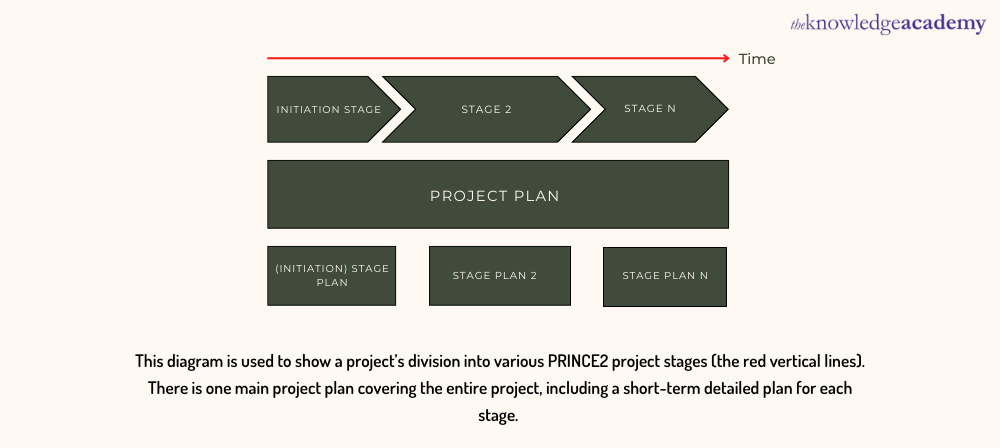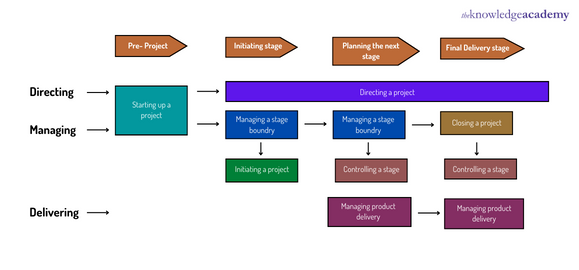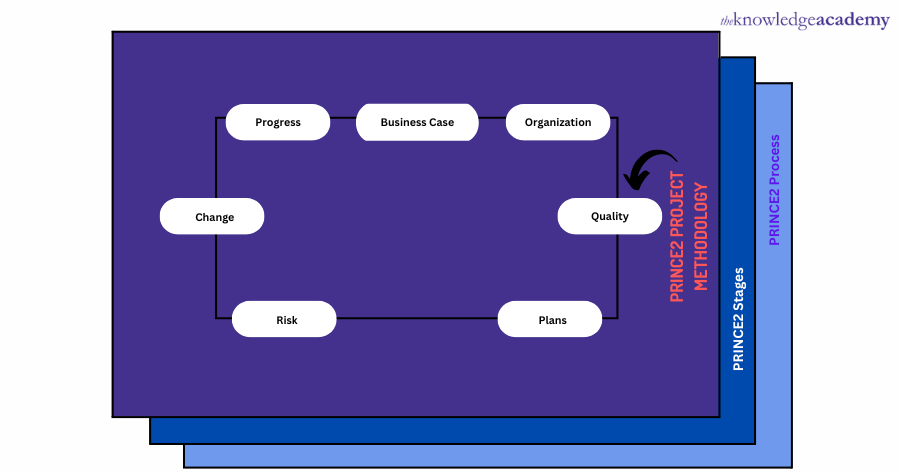We may not have the course you’re looking for. If you enquire or give us a call on +44 1344 203 999 and speak to our training experts, we may still be able to help with your training requirements.
Training Outcomes Within Your Budget!
We ensure quality, budget-alignment, and timely delivery by our expert instructors.

PRINCE2 is an acronym for Projects in Controlled Environments. The original PRINCE methodology of project management was updated in 1996, hence the “2” in PRINCE2 methodology. It is a process-driven project management methodology. This methodology divides the entire project into processes. Each of these processes is managed independently. Each process is defined by its inputs and outputs, precise goals, and activities to be completed.
The PRINCE2 methodology of Project Management focuses on managing resources and risks by dividing projects into smaller stages and controlling the project life cycle with seven PRINCE2 processes. PRINCE2 framework necessitates that projects have well-organised and contained beginnings, middles, and endings. In this blog, we will go into the details of the PRINCE2 project stages and the seven PRINCE2 processes of Project Management.
Table of Contents
1) Let's dive into the PRINCE2 Project Stages
2) What are the Management Stages in PRINCE2?
a) Management Stage 1 - Initiation Stage
b) Management Stage 2 – Planning of the Next Stage
3) PRINCE2 Methodology - Advantages of Working in Stages
4) Understanding Decision Gate in the PRINCE2 Methodology
5) What are the Seven PRINCE2 Processes?
a) Starting up a Project
b) Initiating a Project
c) Directing a Project
d) Controlling a Stage
e) Managing Stage Boundaries
f) Managing Product Delivery
g) Closing a Project
6) Conclusion
Interested to know more about how PRINCE2 works? Register for our PRINCE2® Foundation and Practitioner Training Course now!
Let's Dive into the PRINCE2 Project Stages
The secret behind successful Project Managers managing large chunks of work or projects is that they break it up into smaller pieces that can easily be managed. In PRINCE2 methodology, these manageable chunks are PRINCE2 Project Stages. PRINCE2 projects are planned, monitored, and managed Stage by Stage. The Project Board divides these Management Stages into Decision Points, also known as "Control Points".
At the end of each Stage, the Board evaluates the previous Stage's progress, the Business Case, and the upcoming Stage's plan and determines whether to advance to the next step. When the number of stages in a particular project is high, the Project Board has more influence over the project, but they also have more work. Fewer stages in a project mean that Senior Management will have less power, and the Project Board will have more periodic tasks.
What are the Management Stages in PRINCE2?
PRINCE2 project stage is also known as the management stage. According to the PRINCE2 methodology, any project has at least two management stages: the initiation stage and the planning of the next Stage. The Closing, a Project process of PRINCE2, is the final part of a two-stage project.
Management Stage 1 - Initiation Stage
As the name implies, the Initiation stage occurs at the start of the project. During this Stage, a Project Manager is required to prepare a document named Project Initiation Document (PID). In the PID, the Project Manager has to document the project plan and detailed business case justifying the investment in the project. The PID also contains the strategies for quality management, risk management, changes, communication plan and other benefits of taking up a project.
Management Stage 2 – Planning of the Next Stage
The Project Manager is responsible for preparing a detailed plan for the following management stage of the PRINCE2 methodology. This plan must contain the tasks required for the next PRINCE2 project stage, the needed resources, the schedule and costs, and the outputs. This procedure is known as the planning of the next Stage.
The organisation's decision-makers or the project board further use the PID and this next stage plan to evaluate costs, resources, timescales, and risks and decide whether to move to the next management plan. This entire process occurs at the end of every subsequent management stage, excluding the final Stage, as the project is closed here.
If the project board decides not to move to the next Stage, the project will be closed depending on the evaluation. There will be no more work done except to complete the project and recover anything of value from the previous stages.

Start your journey of Project management with our PRINCE2 Training Course!
PRINCE2 Methodology - Advantages of Working in Stages
Executing your project in stages will provide you with a structured approach to project planning. This will make project teams work more efficiently as they will clearly know the work required.
Project managers get various benefits from dividing their projects into stages. They are:
1) They can divide the entire project into smaller manageable chunks, thereby reducing the clutter
2) Executing projects in stages will ensure that future stage plans may learn from earlier stage’s misdoings
3) Project Managers will be assisted by creating a high-level Project Plan for the entire project as well as a comprehensive Stage Plan for each stage
4) Project Managers can plan, monitor and control the projects on a stage-by-stage basis
Understanding Decision Gate in the PRINCE2 Methodology
The end of any PRINCE2 Project Stage is a decision gate. In this decision gate stage, the project board either approves to move to the next stage or closes the project. Thus, the PRINCE2 project stages help evaluate the time, money and resources required for the project stage-wise and save a lot for the organisation. At the end of each PRINCE 2 stage, the Project board makes a choice ''to move ahead or not''.
What are the Seven PRINCE2 Processes?
The PRINCE2 Project Management methodology uses seven project management processes suitable to any project irrespective of its scale and scope. As PRINCE2 is a controlled environment method, these PRINCE2 processes clearly define the roles and responsibilities of project managers, project board and stakeholders. This way, everyone can be on the same page, and there will be no room for misunderstandings. We have understood what the PRINCE2 project stages are. Now let's move ahead to understanding the seven processes of the PRINCE2 methodology.
Explore more about the benefits of the PRINCE2 Process. Join our PRINCE2 Practitioner Training Course today!

Starting up a Project
This is the first PRINCE2 process. In this pre-project process, it is assessed whether the project should be taken up or not. To do this, in this stage, a project brief, business case, and detailed stage plan that will provide the project mandate are developed by the project manager.
In this PRINCE2 process, project managers, the project team and the project board are appointed. The role of the Project manager and Project board is to ensure that investment of time and resources is made, taking into account the risks to the project.
The starting up of a project PRINCE2 process is done once in each project to gain the authorisation necessary for the following process - initiating a project.
Initiating a Project
This process involves planning in detail, i.e., planning timescale, budget, quality, scope, risk, benefits and communication management strategies. This output document containing these details is prepared by the Project Manager and is called Project Initiation Document (PID).
The Project Manager has to set up project controls and project files and assemble a Project Initiation Document (PID) in this second PRINCE2 process.
Directing a Project
Directing a project PRINCE2 process spans from the project's starting stage to the project's closing. This process has mainly to do with the responsibilities of the Project Board. Under this PRINCE2 process, the project board assigns the project manager day-to-day responsibilities. The Project Board still makes critical decisions and ultimately controls the project. Through this process, the Project Board is kept accountable for its decisions.
The Project Board has the authority to initiate the project, deliver the product and close the product. They also offer direction to the project and decide after every stage of the project whether to continue or complete the project. If the project board approves and decides to move ahead with the next stage, they identify all resources needed and delegate them to the Project Manager.
Project Board also collaborates with business entities to assess post-project benefits. Authorising the beginning, the project itself, and the project stages are all activities associated with directing a project PRINCE2 process.
Controlling a Stage
This PRINCE2 project process defines the Project Manager's monitoring progress and controlling tasks. This is where the project manager assigns tasks to the project team, oversees the work, deals with any difficulties that emerge, and reports to the project board on the progress of the project activities.
The controlling a stage process describes the project manager's activities within each project's management stage, including project authorisation, assessing project progress, reviewing stage progress, reporting highlights, escalating project issues and taking mitigating actions, and submitting the appropriate reports to the Project Board.
Managing Stage Boundaries
This PRINCE2 process offers the Project Board critical decision points for whether or not to proceed with the project. In this process, the project manager evaluates performance to the project board, updates the project plan and business case, and develops a strategy for the next stage. All this information by the Project Manager assists the Project Board in reviewing the current stage, approving the next stage, and reviewing the revised plan. The Project Board assess the project at every stage for quality and adherence to the plan.

The key activities in this process include:
1) Preparing for the next stage and reporting on the stage's completion
2) Updating the project plan
3) Risk register
4) Business case
Managing Product Delivery
This project process governs the link between the Project Manager and the team managers. This process is based on the customer or supplier environment. The process of managing product delivery explains the team manager's responsibilities as a provider, that is, in achieving the goals of a work package.
The key activities associated with this process include:
1) Accepting the work package
2) Executing the work package
3) Reviewing the completed project tasks
4) Comparing the progress with the original project brief
5) Delivering the work package
Afterwards, the project manager has to obtain approval for the completed work package from the Project Board.
Closing a Project
In this PRINCE2 project process, the Project Manager has to ensure that the goals and objectives of the project are achieved per the PID by the deadline. Project Managers are responsible for ensuring that the project products are delivered, evaluating the project, submitting the project and recommending the project closure to the Project Board.
The project manager must complete any remaining documentation and reporting and update the issue register during this process. Also, sometimes the Project managers may prepare both the scheduled and unplanned project closures, although this is not essential. The Project Manager has to get approval from the Project Board at the end of the project, and the board will give final approval after assessing the project deliverables.
Conclusion
A Project Manager must carry out frequent Process reviews throughout the lifecycle of a project. As a Project Manager, you will have the flexibility to use PRINCE2 or any other Project Management methodology of your choice to manage your project. We hope we have provided you with the required information about the PRINCE2 stages and PRINCE2 processes to make your decision while choosing the project methodology. Let us know in the comments below if you have any doubts or questions.
Frequently Asked Questions

PRINCE2 project stages enhance management and governance by structuring projects into clear phases, allowing for regular reviews, risk assessment, and progress evaluation. This ensures alignment with business goals, enables proactive adjustments, and improves accountability across the project lifecycle.

Successful PRINCE2 stage closure should always involve defining objectives, updating the plan, reviewing risks, and check and deliverables. Ensure that there is a proper communication so as to maintain coordination in implementing the various roles of the team members; to seek for a stage-end approval so that the team can easily relocate to the next phase of the business.

The Knowledge Academy takes global learning to new heights, offering over 30,000 online courses across 490+ locations in 220 countries. This expansive reach ensures accessibility and convenience for learners worldwide.
Alongside our diverse Online Course Catalogue, encompassing 19 major categories, we go the extra mile by providing a plethora of free educational Online Resources like News updates, Blogs, videos, webinars, and interview questions. Tailoring learning experiences further, professionals can maximise value with customisable Course Bundles of TKA.

The Knowledge Academy’s Knowledge Pass, a prepaid voucher, adds another layer of flexibility, allowing course bookings over a 12-month period. Join us on a journey where education knows no bounds.

The Knowledge Academy offers various PRINCE2 Training, including the PRINCE2 Foundation & Practitioner Training Course, PRINCE2 Agile Foundation and the PRINCE2 Foundation. These courses cater to different skill levels, providing comprehensive insights into PRINCE2 Case Studies.
Our Project Management Blogs cover a range of topics related to PRINCE2 Agile and Foundation, offering valuable resources, best practices, and industry insights. Whether you are a beginner or looking to advance your Project Management skills, The Knowledge Academy's diverse courses and informative blogs have got you covered.
Upcoming Project Management Resources Batches & Dates
Date
 PRINCE2® Foundation & Practitioner Training Course
PRINCE2® Foundation & Practitioner Training Course
Mon 6th Jan 2025
Sat 11th Jan 2025, Sun 12th Jan 2025
Mon 13th Jan 2025
Mon 20th Jan 2025
Mon 27th Jan 2025
Mon 3rd Feb 2025
Sat 8th Feb 2025, Sun 9th Feb 2025
Mon 10th Feb 2025
Mon 17th Feb 2025
Mon 24th Feb 2025
Mon 3rd Mar 2025
Sat 8th Mar 2025, Sun 9th Mar 2025
Mon 10th Mar 2025
Mon 17th Mar 2025
Mon 24th Mar 2025
Mon 31st Mar 2025
Sat 5th Apr 2025, Sun 6th Apr 2025
Mon 7th Apr 2025
Mon 14th Apr 2025
Tue 22nd Apr 2025
Mon 28th Apr 2025
Sat 3rd May 2025, Sun 4th May 2025
Tue 6th May 2025
Mon 12th May 2025
Mon 19th May 2025
Tue 27th May 2025
Mon 2nd Jun 2025
Sat 7th Jun 2025, Sun 8th Jun 2025
Mon 9th Jun 2025
Mon 16th Jun 2025
Mon 23rd Jun 2025
Mon 30th Jun 2025
Sat 5th Jul 2025, Sun 6th Jul 2025
Mon 7th Jul 2025
Mon 14th Jul 2025
Mon 21st Jul 2025
Mon 28th Jul 2025
Sat 2nd Aug 2025, Sun 3rd Aug 2025
Mon 4th Aug 2025
Mon 11th Aug 2025
Mon 18th Aug 2025
Tue 26th Aug 2025
Mon 1st Sep 2025
Sat 6th Sep 2025, Sun 7th Sep 2025
Mon 8th Sep 2025
Mon 15th Sep 2025
Mon 22nd Sep 2025
Mon 29th Sep 2025
Mon 6th Oct 2025
Sat 11th Oct 2025, Sun 12th Oct 2025
Mon 13th Oct 2025
Mon 20th Oct 2025
Mon 27th Oct 2025
Sat 1st Nov 2025, Sun 2nd Nov 2025
Mon 3rd Nov 2025
Mon 10th Nov 2025
Mon 17th Nov 2025
Mon 24th Nov 2025
Mon 1st Dec 2025
Sat 6th Dec 2025, Sun 7th Dec 2025
Mon 8th Dec 2025
Mon 15th Dec 2025







 Top Rated Course
Top Rated Course



 If you wish to make any changes to your course, please
If you wish to make any changes to your course, please


